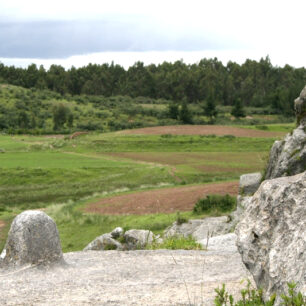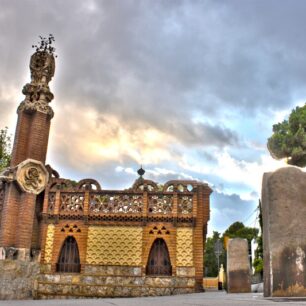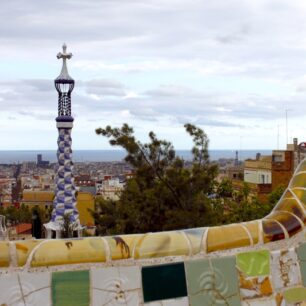Getting There and Practical Tips
Montjuïc Hill rises gently above Barcelona’s harbor, offering one of the most scenic and historical walks in the city. It’s easy to reach by walking or public transport — take the metro to Paral·lel Station and then the funicular up the hill. Buses also stop near the Olympic Stadium.
Most of Montjuïc’s gardens and outdoor attractions are free to visit. The area is large, so plan at least half a day to explore; a full day is even better if you want to relax in the gardens or enjoy a sunset picnic.
Food options range from simple cafés around the stadium to small local spots near Plaça d’Espanya. You can also bring your own snacks and enjoy them on a shaded bench among the trees.

The Telefónica Tower: A Symbol of Modern Barcelona
The white, futuristic structure that dominates the Olympic Park is the Telefónica Tower, also known as the Calatrava Tower, designed by the famous architect Santiago Calatrava. Built between 1989 and 1992, it served as the main communications tower for the Barcelona Olympic Games.
Its elegant form represents an athlete holding the Olympic flame. The white steel design rises 136 meters high and can be seen from across the city. The base is decorated with a mosaic technique called trencadís, made from broken tiles — a traditional Catalan style inspired by Gaudí.
An amazing curiosity is that the tower also acts as a giant sundial. Its shadow marks the hours across the plaza floor depending on the position of the sun.
Travel Tip: The plaza around the tower is free to visit and offers a wonderful panoramic view of the city. Come in late afternoon when the white steel glows with the golden light of the sunset.


The Olympic Stadium: Estadi Olímpic Lluís Companys
The Olympic Stadium is another highlight of Montjuïc. It was first built in 1929 for the International Exposition but remained mostly unused until it was completely renovated for the 1992 Summer Olympics.
During the Games, it hosted the opening and closing ceremonies, and it became a global symbol of the new, modern Barcelona. Today, the stadium is still in use for major sports events and concerts.
The outer facade preserves its 1929 design, while the interior was rebuilt with modern technology. The large plaza around it, called the Olympic Ring, is home to fountains, sculptures, and open spaces that connect the stadium to other attractions on the hill.
Useful Info: You can walk around the outside for free, and sometimes the interior is open for visits. Near the stadium you’ll find the Olympic flame monument — a great photo stop.
Curiosity: The stadium’s name honors Lluís Companys, a Catalan president who was executed during the Spanish Civil War, adding a deep layer of historical meaning to the site.

The Marathon Runner Monument: Hwang Young-Jo
Near the stadium stands a lesser-known but very touching monument — a stone statue of Hwang Young-Jo, the South Korean marathon runner who won the gold medal in the 1992 Olympics.
This monument was a gift from Korea to the city of Barcelona, symbolizing the friendship between the two nations and celebrating Hwang’s victory on Montjuïc, where the marathon race ended.
Travel Tip: After visiting the stadium, walk a few minutes toward the finish line area of the marathon route to find this monument. It’s a quiet, emotional place — perfect for reflecting on how sports can connect cultures.
Curiosity: The monument was placed on the exact area where Hwang crossed the finish line, making it one of the most meaningful spots in the Olympic Park.


The Amphitheatre and Gardens of Montjuïc
If you walk further down the hill, you’ll find the Jardins del Teatre Grec, or Greek Theatre Gardens. Built in the 1920s on the site of an old quarry, these gardens feature an open-air stone amphitheatre inspired by ancient Greece.
Every summer, concerts and performances take place here as part of Barcelona’s Grec Festival. When it’s quiet, the terraces and flower beds make it a peaceful spot to rest.
Nearby are several other gardens — Laribal, Mirador, Costa i Llobera (a cactus garden), and more. Each one has its own style: some filled with roses, others with Mediterranean trees and waterfalls.
Travel Tip: Take your time to wander. The gardens are free and full of hidden corners. Sit under the pine trees, listen to the birds, and enjoy the views over the city and sea.
Curiosity: The Jardins de Laribal hide a small waterfall and a ceramic fountain designed by architect Jean Claude Nicolas Forestier — a forgotten gem of 1920s landscape art.


The Sound Telescope: Jardins de Joan Brossa
On the lower slopes of Montjuïc you’ll find the Jardins de Joan Brossa, a green area built on the site of an old amusement park. The park was transformed into gardens dedicated to the Catalan poet Joan Brossa, and it’s full of playful sculptures and sensory installations.
One of the most unique features is the Sound Telescope, an acoustic sculpture that invites you to listen to distant sounds carried by the wind. You lean your ear to the structure and hear the whispers of the city, birds, and sea.
Travel Tip: These gardens are perfect for families or those seeking a quieter place to rest. You’ll find picnic spots, playgrounds, and shaded paths.
Curiosity: This area was once home to a popular funfair. Today, instead of the noise of rides, you’ll hear the peaceful sounds of nature — a beautiful transformation.



Suggested Walking Route
- Start at the top: Telefónica Tower (Calatrava Tower)
- Continue to the Olympic Stadium and Marathon Monument
- Stop for lunch or a picnic in one of the open spaces
- Walk down to the Greek Theatre Gardens and Laribal Gardens
- Finish at the Jardins de Joan Brossa and enjoy the Sound Telescope before sunset
This route will take around 3 to 5 hours at a relaxed pace.

Fun Facts and Hidden Gems
- The Telefónica Tower’s white color represents purity and peace, matching the Olympic spirit.
- The tower’s shadow works as a giant sundial — stand in the plaza at midday to see it mark the time.
- The Olympic Ring design allows perfect alignment between the stadium, tower, and Palau Sant Jordi, creating a symbolic unity.
- The amphitheatre garden was once a quarry that supplied stone for other parts of Barcelona.
- In the Laribal Gardens you can still find the same type of tiles Gaudí used in Park Güell.
- Montjuïc’s name comes from Latin and means “Jewish Mountain”, as a Jewish cemetery once stood on its slopes.

Final Thoughts
Montjuïc is a journey through time. From 1929’s grand exhibitions to the glory of the 1992 Olympics and today’s peaceful gardens, it tells the story of Barcelona’s transformation.
Whether you come for the views, the architecture, the gardens, or simply to breathe above the busy city, Montjuïc always rewards those who take the time to explore slowly.

Until the next horizon, travel with joy





